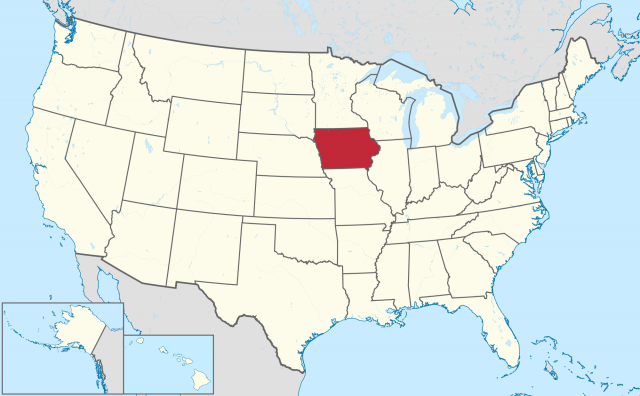Iowa
IOWA IS A midwestern state in the north-central part of the UNITED STATES bordered on two sides by major rivers. To the east is the MISSISSIPPI that separates Iowa from ILLINOIS and WISCONSIN. In the west, the Missouri River separates it from NEBRASKA, while the Big Sioux River separates it from SOUTH DAKOTA from Sioux City northward. To the north lies MINNESOTA and to the south MISSOURI.
Interestingly, there is a small heel of Iowa that extends south into Missouri in the southeastern corner of the state along the MISSISSIPPI RIVER. Here, Iowa actually has a western boundary with Missouri, since you can leave the city of Keokuk and drive westward into Missouri.

The state's rich, fertile plains are generally low and gently sloping for the eastern three-quarters of the state. Rivers in the area, including the Des Moines River, which flows from Minnesota through the middle of the state, all flow in a southeasterly direction toward the Mississippi River. There is a small region in the extreme northeastern corner that was not glaciated during the last ice age that Iowans often refer to as the Switzerland of Iowa because of the visual effect the sharp cuts in the river bluffs along the Mississippi River give to the landscape.
The western one-quarter of the state is somewhat higher in elevation, with numerous rivers dissecting the hill country along the western border as they flow in a southwesterly direction toward the Missouri River. Elevations in the state range for a low of 380 ft (116 m) above sea level in the boot heel region in the very southeastern corner to 1,670 ft (509 m) at Hawkeye Point in the northwestern corner of the state. Slightly more than 100 years ago, you would find extensive woodlands of hickory and black walnut in the state as well as extensive prairies with grass higher than the wagon wheels of the settlers' wagons. But rapid settlement during the 19th century brought on rapid deforestation and the plow turned nearly all of the prairie grasslands into farmland for corn and other grains.
Des Moines (pronounced without the “s” sound in either word) is the capital and largest city, with 198,682 residents (2000). Other important cities near or above the 100,000 mark are Cedar Rapids (120,758) and Davenport (98,359). Iowa ranks 30th in total population, with 2,926,324 residents, and 26th in land area at 56,276 square mi (145,756 square km). The state's 10 largest cities account for 29 percent of the total population, enough to drop the density feeling as you drive around the state to 36 persons per square mi (94 per square km) from the official figure of 52.37 per square mi (136 per square km). Iowa ranks 33rd in per capita income ($26,431) and 35th in disposable per capita income ($22,949).
EARLY SETTLERS
Prior to the first Europeans coming to Iowa, the area was home to prehistoric Native Americans mound builders who were primarily farmers. By the time the Europeans arrived in the 17th century, the Iowa, Sac, and Fox roamed over the land, in addition to the Sioux who dominated the area. Fur traders found the land profitable during the late 1600s, establishing a number of small towns along the Mississippi River and Des Moines River junction.
By the late 1700s, the area near present-day Dubuque was leased from the Indians for lead mining. Iowa came into the control of the UNITED STATES in 1803 following the LOUISIANA PURCHASE. Until 1821, Iowa was part of the Missouri Territory. After 1821, Iowa was part of both the Michigan Territory and Wisconsin Territory prior to being organized as the Iowa Territory in 1838. With a reputation for rich soil, Iowa grew rapidly as new immigrants flocked to the state. Many of these came from Europe, notably Germans, Czechs, Dutch, and Scandinavians, bringing their agricultural skills and own customs to enrich Iowa's rural life. One group of German Pietists established the Amana Church Society, a successful attempt at communal organization still recognizable as the Amana Colonies. Iowa became a state in 1846 and in 1857 the capital was moved from Iowa City to Des Moines.
Iowa truly is a breadbasket for the United States with 90 percent of the land devoted to farming. The deep, porous soils help sustain yields in corn and other grains in tremendous quantities. Iowa often leads the nation in the production of corn, soybeans, hogs, and pigs, and is ranked in the top 10 in the raising of cattle. Iowa corn-fed hogs and cattle are nationally known. And Iowa consistently ranks high among farm states in terms of farm income. Abundant and consistent agriculture yields have also benefited the state's food processing industry. Non-electrical machinery, farm machinery, tires, appliances, electronic equipment, and chemicals are among the other manufactured products. Mineral production is small and centered around cement (the most important mineral product) stone, sand, gravel, gypsum, and some coal. Communications, finance, and insurance are especially important in Des Moines; the area is often referred to as the Hartford (from Hartford, CONNECTICUT, insurance companies)
of the Midwest.